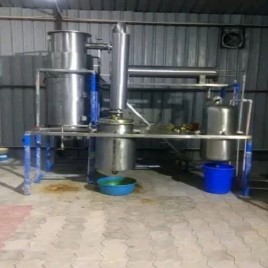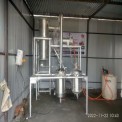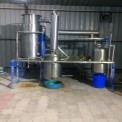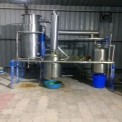Home » Extraction Plants and Extruders » Solvent Extraction Plant
Solvent Extraction Plant
A solvent extraction plant separates oil from oil-bearing materials – these materials include seeds, nuts, or other plant matter. The plant does this with chemical solvents. This process takes oil from materials that have little oil, typically less than 20 percent. It also works for seeds with much oil after an early mechanical pressing. The plant relies on certain solvents, most often hexane, to dissolve oil from the solid material – this leaves a deoiled meal. To operate, the plant first prepares the raw material. That may involve cleaning, cracking, flaking, or prepressing, depending on how much oil the material holds. Workers then expose the prepared material to the solvent in a controlled setting. The solvent gets into the material and dissolves the oil. The mix that results, called miscella, has oil and solvent. Workers separate this miscella from the solid remains. These remains then go through more steps to remove leftover solvent by desolventising and toasting; this creates a byproduct, a protein-rich animal feed. The miscella goes through distillation. This recovers the solvent so it can be used again – it also separates the crude oil, which gets refined later. Solvent extraction works very well, leaving under one cent of oil in the remaining cake – this gets the most oil and lessens waste. The process also uses less energy than mechanical pressing. It can also be automated, which keeps product quality steady and operations productive. Solvent extraction plants are needed to make edible oils and special oils along with industrial lubricants from many kinds of oil-bearing materials. Discover a wide selection of solvent extraction plants at AAJJO – shop now for the best deals! Read more
Related Categories
- Extrusion Plant
- Motorized Bearing Extractor
- Herbal Extraction Plant
- Rice Bran Solvent Extraction Plant
- Horizontal Rotary Extractors
- Extruder Machine
- Automatic Gold Refining Machine
- Blown Film Extrusion Machine
- Silver Refining Plant
- Gold Refining Plant
- Gold Refinery Machine
- Silver Recovery Unit
- Liquid Extraction Plant
- Tube Extrusion Machine
Oleoresin Extraction Equipment
₹ 10,00,000
Get Best Price| Brand: Others |
| Automation Grade : Semi Automatic |
| Frequency : 50 Hz |
| I Deal In : New Only |
| Material : Stainless Steel |
₹ 1,00,00,000
₹ 50,00,000
Sunflower Seed Solvent Extraction Plant
₹ 5,00,00,000
Get Best Price| Brand: Others |
| Automation Grade : Automatic |
| Capacity : 200 TPD |
| Installation Services : Yes |
| Material : SS, MS |
₹ 4,00,00,000
₹ 4,00,00,000
₹ 40,00,000
Stainless Steel Pilot Herbal extraction plant, Capacity: 100-kg
₹ 5,00,000
Get Best Price| Brand: Others |
| Automation Grade : Manual |
| Brand : Accurate Engineering Works |
| Machine Type : Herbal extract |
| Power Source : Electric |
Share Your Requirements
For a Quick response, Please fill up the details below.
Turmeric / Curcumin Solvent Extraction Plant
₹ 12,00,000
Get Best Price| Brand: Others |
| Automation Grade : Semi Automatic |
| Brand : make in india |
| Installation Services : Yes |
| Material : Stainless Steel |
Solvent Extraction Plant, Capacity: 100 TPD
₹ 7,50,00,000
Get Best Price| Brand: Others |
| Automation Grade : Automatic |
| Capacity : 100 TPD |
| Country of Origin : Made in India |
| Installation Services : Yes |
Curcumin Solvent Extraction Plant
₹ 8,00,000 9,00,000 11.00% Off
Get Best Price| Brand: Others |
| Automation Grade : Automatic |
| Material : Mild Steel |
| Minimum Order Quantity : 1 |
| Model : Mild Steel Solvent Extraction Plant |
₹ 14,00,000
Gagan International Mild Steel Solvent Extraction Plant
₹ 5,00,000
Get Best Price| Brand: Others |
| Automation Grade : Automatic |
| Brand : Gagan International |
| Driven Type : Electric |
| Motor : 2 - 3 HP |
Continuous Solvent Extraction Plant
₹ 1,50,00,000
Get Best Price| Brand: Others |
| Corrosion Resistance : Yes |
| Feature : Heavy Duty |
| Surface Finishing : Coated |
| Type : Highly Durable |
₹ 1,00,00,000
Solvent and Naphtha Plant
₹ 40,00,000
Get Best Price| Brand: Others |
| Automation Grade : Automatic |
| Frequency : 50 Hz |
| humidity : 85 % |
| Power Source : Electric |
Best Engineering Stainless Steel Bixin Extraction Plants, For Industrial, Capacity: 1000 kg
₹ 1,30,00,000
Get Best Price| Brand: Others |
| Automation Grade : Automatic |
| Brand : Best Engineering |
| Frequency : 50 Hz |
| Power Source : Electric |
Solvent Extraction Plant
₹ 5,00,000
Get Best Price| Brand: Others |
| Noise level : Less than 40 dB |
| Power : 220 W |
| Usage : for Industrial |
| Water Tank Capacity : 9L |
₹ 5,65,000
Mild Steel Solvent Extraction Plant
₹ 20,00,000
Get Best Price| Brand: Others |
| Automation Grade : Automatic |
| Material : Mild Steel |
| Minimum Order Quantity : 1 Piece |
| Model : Mild Steel Solvent Extraction Plant |
₹ 3,00,00,000
Automatic Solvent Extraction Plant
₹ 12,50,000
Get Best Price| Brand: Others |
| Automation Grade : Semi Automatic |
| Brand : ATMIYA |
| Capacity : 5000 TPD |
| Country of Origin : Made in India |
SEW Phytochemicals Extraction Plant
₹ 5,00,000
Get Best Price| Brand: Others |
| Brand : SEW |
| Finishing : Polished |
| Installation Services : Yes |
| Material : Stainless Steel |
Herbal / Bio-Pesticides Machinery
₹ 75,00,000
Get Best Price| Brand: Others |
| Brand : ARKChem |
| Capacity : 60-240 bottles/min |
| Category : Plant & Machinery |
| Color : STD |
₹ 5,00,000
₹ 60,00,000
₹ 1,50,00,000
SS Solvent Extraction Plant
₹ 7,50,000
Get Best Price| Brand: Others |
| Model : Solvent Extraction Plant |
₹ 7,50,000
Solvent Extraction Plant
₹ 22,00,000
Get Best Price| Brand: Others |
| Automation Grade : Automatic |
| Power Source : Electric |
| Usage/Application : Food pharmaceuticals |
| Voltage : 440 V |
Herbal Extraction Plant, Capacity: Upto 5 Tons/day
₹ 10,00,000
Get Best Price| Brand: Others |
| Automation Grade : Automatic |
| Capacity : upto 5 tons/day |
| Frequency : 50-60 Hz |
| Installation Services : Yes |
₹ 1,00,00,000
₹ 10,00,000
Solvent Recovery Plant
₹ 8,50,000
Get Best Price| Brand: Others |
| Automation Grade : Automatic |
| Capacity : 100 Litres |
| Country of Origin : Made in India |
| Design Type : Standard |
KIRAN Automatic Curcumin Extraction Plant, Capacity: 10 TPD 100 TPD
₹ 36,00,00,000
Get Best Price| Brand: Others |
| Brand : KIRAN |
| Delivery Time : 18 Months to 24 Months |
| Design Type : Customized |
| Installation Services : Yes |
Physical And Chemical Refinery
₹ 7,50,00,000
Get Best Price| Brand: Others |
| Brand/Make : ADITYA |
| Capacity : 10 TPD TO 200 TPD |
| Country of Origin : Made in India |
| Deal In : New |
Copper Extraction Plants
₹ 25,00,000
Get Best Price| Brand: Others |
| Automation Grade : Semi-Automatic |
| Country of Origin : Made in India |
| I Deal In : New Only |
| Power Source : AC |
₹ 25,00,000
Cooker Solvent Extraction
₹ 10,00,000
Get Best Price| Brand: Others |
| Capacity : 1000 TPD |
| Material : Mild Steel |
| Model : Cooker Solvent Extraction |
| Shell Thickness : 10 mm |
₹ 4,00,00,000
SEW Phytochemicals Extraction Plant
₹ 5,00,000
Get Best Price| Brand: Others |
| Material : Stainless Steel |
| Usage/Application : Extraction |
Dakshin Kannad, Karnataka
Related Videos


Featured Categories
- Industrial Belts & V Belts
- Water Treatment & Purification Plant
- Liquid Packaging Machinery
- Pumps, Pumping Machines & Spares
- Printing Machinery & Equipment
- Wrapping & Banding Machines
- Moulding Machine
- Conveyor Systems & Components
- Industrial Mixing Machine
- Industrial Coolers, Blowers & Fans
- Industrial Valves & Valve Fittings
- Dryers & Evaporators
- Process Tanks & Chemical Reactors
- Fast Food & Beverages Machinery
- Mechanical Parts & Spares
- Pollution Control Devices & Machines
- Filter Assemblies and Spare Parts
- Oil Mill & Oil Extraction Machinery
- Pharmaceutical Machinery & Equipment
- PVC, LDPE, HDPE & Plastic Sheets
- Brakes & Braking Systems
- Strapping & Sealing Machines
- Woodworking Tools & Machines
- Packaging Machines & Goods
- Machines & Equipments
- Testing & Measuring Equipments
- Chemical Plants & Machinery
- Plastic Work & Processing Machines
- Filters & Filtration Systems
- Paper Work & Making Machine
- Industrial Mixers & Homogenizers
- Die Casting Mould & Moulding Tools
- Chemicals, Dyes & Allied Products
- Footwear Machinery
- Separators, Strainers & Purifiers
- Hand & Machine Tools
- Crusher, Shredder & Presses
- Fruit & Vegetable Processing Machine
- Storage Tanks, Drums & Containers
- Lab Instrument
- Bakery & Dairy Machinery
- Rubber, Rubber Processing Machinery
- Industrial Chemicals
- Material Handling Machines & Systems
- Milling & Grinding Tools
- Cutting Machines & Equipment
- Bar, Neodymium & Permanent Magnets
- Hydraulic & Pneumatic Machines
- Soap & Sanitizer Dispenser
- Machine & Precision Tools
- Protective Packing Materials
- Industrial & Engineering Goods
- Air Compressors, Accessories & Parts
- Drilling Bits, Collets and Chucks
- CNC Machines & Lathe Machine
- PVC, FRP, HDPE & Other Plastic Pipes
- Surface Coating & Paint Equipment
- Drilling & Boring Equipment
- Wire Drawing & Cabling Machines
- Filling Machines & Plants
- Chemical Reactors and Process Tanks
- Casting, Moulding & Forging Machines
- Industrial Air Conditioner & Devices
- Industrial Furnaces & Ovens
- Gearbox, Axle, Sprocket & Gear Parts
- Oxygen & Nitrogen Gas Plants
- Meat & Seafood Processing Equipments
- Bending & Metalwork Machines
- Weight Bowl & Weighting Scale
- Musical Equipment & Accessories
- Incinerator
- Laser Marking & engraving Machine / System
- Sewing,Knitting & Embroidery Machine
- Welding Equipments & Machinery
- Apparel & Textile Machinery
- Boilers & Boiler Parts
- Used Machinery & Tools
- Binding and Pressing Machines
- Closing & Sealing Machines
- Jewellery Making Tools & Machines
- Cutting Tools & Milling Cutter
- Hydraulic & Pneumatic Cylinders
Top Solvent Extraction Plant Manufacturer and Supplier
Solvent Extraction Plant related Questions/Answers
What is a solvent extraction plant?
The solvent extraction plant is a facility where oil is extracted from seeds or raw materials using a chemical process. Hexane is the most common solvent used. Its popularity comes from the fact that this method extracts almost all oil from the raw material.The process begins by first cleaning the seeds and then grinding them. The crushed seeds are fed into the extractor. The solvent is then added, and the solvent is mixed with the oil, allowing it to solubilise, thus removing it from its solid matrix. The mixture is then transferred to the distillation unit.In distillation, the oil is separated from the solvent. The solvent is collected and reused. The oil is purified and further refined. The remaining solid part is called 'meal', dried, and used as animal feed or fertiliser.Solvent extraction plants are common in the vegetable oil industry. They are employed in peanut, soybean, and sunflower seed extraction of oil from extractions. Yields from this technique surpass those of mechanical pressing.There should be observance of safety rules in these companies. Their solvents—hexane among them—are combustible and should be handled carefully. One absolutely needs enough ventilation and firefighting systems.All things considered, the solvent extraction plant helps to maximise oil from seeds. The most used method in oil production, it is also economical and quick.
What is the cost of solvent extraction plant?
Capacity, type of seed, site, and the level of automation are the determinants most significantly affecting the prices of a solvent extraction plant. A small solvent extraction plant in India costs ₹30–50 lakh and can process 10–20 tonnes of seeds daily, suitable for small to medium industries. A medium plant handles 50–100 tonnes per day and costs ₹1–5 crore. These machines come with superior equipment and include added safety features. These setups recover oil well on account of their higher efficiency and reliability as compared to smaller setups. Large industrial plants can process over 200 tonnes of seeds per day. Their cost ranges from ₹10 crore to over ₹25 crore. These plants use high-end technologies. Their systems are fully automated. They offer high efficiency and better control. Meal dryers, distillation systems, and oil refining facilities fit into this category as well. Land, building, and installation as well as licensing costs account for other expenses. Utilities, maintenance, and manpower are important costs. They are higher than the earlier setup costs. Still, they are necessary for smooth operations. Many firms include them in their planning. These costs affect long-term efficiency. A number of suppliers also supply such turnkey projects, right from design to setup. Imported machinery is more expensive than domestic but usually provides a more efficient machine with an extended period of use. In brief, the plant cost differs completely from one solvent extraction plant to another. It greatly depends upon the production size and features of the plant. Therefore, proper planning and budgeting are required before setting up the plant.
Which products can be extracted in a solvent extraction plant?
Commonly referred to as a solvent extraction process, a solvent extraction plant or group of plants is used mostly to extract oil from oil-bearing seeds and other materials. Apart from soybean oil, sunflower oil is most likely the next most crucial good. A clear, light oil is extracted from sunflower seeds by a series of processes. Another oil, groundnut oil (known as peanut oil), is also produced in the plant. It is fairly strong in flavour and used in cooking. Cottonseed oil is another one, extracted from the cotton plant seed and refined. Some others include rapeseed or canola oil, which is from rapeseed and nowadays is used in cooking applications and processed food enterprises. Some plants also extract oil from coconut and palm kernels. Cooking, cosmetics, and soap making all need these oils. Apart from oils, the solid waste or meal is either applied for fertilisation or used as animal feed. The solvent extraction plant can extract valuable oils. It works on several types of seeds and raw materials. The extracted oils are used in the food industry. They are also used in medicine. These oils have industrial uses as well. This makes the process useful in many sectors.
What is the capacity of solvent extraction plant?
A solvent extraction plant is determined by the capacity of the plant and its associated design. Small-scale plants can handle an approximate capacity of 10 to 20 tonnes of seeds per day; incentives to set up small industries or startups. They are generally very easy to install and run. Their capacities can range up to 50 to 100 tonnes in a medium-scale plant. This kind of capacity is ideal for growing companies. Better efficiencies with higher oil recovery; of course, the cost is also higher in comparison to the smaller-sized units. Large-scale industries manage heavy processing plants, and these can handle 200 tonnes per day or even more. Some of the advanced ones even go up to 500 tonnes a day. These are the facilities used by major oil companies. It is fully automated and works with advanced systems. Furthermore influencing capacity is the type of raw material. While some seeds, such as cottonseed or rice bran, may need particular care, some, such as soybeans, are high in oil and simpler to prepare. Furthermore, influencing the yield of oil and meal is seed quality and moisture content. More efficient machines give higher recovery rates. Basically, solvent extraction machines may daily handle anything from about 10 tonnes to more than 500 tonnes. The availability of seeds and market demand influence the capacity in addition to production needs. Good planning guarantees efficient running and improved results.
Which equipment is required for solvent extraction?
For a solvent extraction plant, several significant machines exist; each has a different function in the whole operation. The first one is a seed cleaner. It helps to eliminate all other kinds of trash, including dust and stones. The next equipment breaks down the seeds into tiny pieces to release more oil—a crusher or grinder. The stuff next passes into the primary machine, the solvent extractor, where the seeds are treated with a solvent like hexane. The oil dissolves in the solvent, then the mixture of oil and solvent is delivered to the distillation unit, where heat is used to separate the oil and solvent. The solvent evaporates and leaves behind pure oil.The vapour is chilled through a condenser, converting it back into liquid solvent. The solvent is collected and reused. A desolventizer-toaster (DT) performs the job of removing any residual solvent from the solid material. The solid meal is then dried and fed to the animals.Other equipment includes pumps and filters. Storage tanks are also used. Control panels help operate the machines. Fire control systems are very important. Ventilation is needed for safety. Other safety tools must also be in place. These protect the plant and workers.All things considered, the plant will require machinery for crushing, cleaning, extraction, distillation, and drying. All of these should provide a flawless, safe, and fast procedure taken together.
What is oil solvent extraction plant?
A melting pot of mechanised gizmos, the oil solvent-extraction plant is a place where oil is extracted from oil seeds by chemical processing. Innovation takes its course as the oil extraction is based upon the use of a solvent as opposed to traditional methods, where the oil is expelled by squeezing. Hexane is the most often used solvent among these ones. The seeds are first crushed and cleaned to boost surface area. The crushed seeds then are combined with the solvent, which breaks oil from the solid sections. The mixture of oil and solvent then passes to the distillation unit and is heated there. The solvent evaporates off from the oil. The vapour is then cooled, condensed, and reused. The purified oil is then sent for refining, and the remaining solids are referred to as "meal", which is dried and marketed as animal feed. The plant consists of seed-cleaning machines, extractors, distillation units, condensers, and dryers. Auxiliary installations like pumps, filters, and safety systems are also included. This process gives a significantly higher yield of oil than mechanical pressing. It is predominantly used for processing soybeans, sunflower seeds, cottonseed, and rice bran. Oil solvent extraction is preferred by large oil industries for its superior efficiency. An oil-solvent extraction plant helps get more oil from seeds. It uses solvents to extract the oil. This method is cost-effective. It gives a higher oil yield than pressing. The process is efficient and reliable. It is widely used in the oil industry. Many oil companies prefer this method.
Which solvent is best for extraction?
Hexane is largely acceptable as the most extensively used solvent for oil extraction. This colourless liquid is derived from petroleum. Hexane is preferred for those reasons: it dissolves oil from seeds and other raw materials with great ease. Hexane has a low boiling point. Therefore, it can be very easily distilled off from the oil. It evaporates quickly and leaves negligible residue, thus helping in obtaining neat oil after the extraction. Hexane is also economical and easy to work with. The solvent can be used several times in the entire extraction cycle. This makes the process more economically viable for the industry. It also gives higher oil recovery as compared to mechanical pressing.Other solvents like that of ethanol, acetone, and isopropanol can also be used. However, they are less commonly applied in industrial oil extraction. These are employed mostly in special cases or in laboratory-scale operations. They may be costlier or may require more careful implementation of safety measures.Nevertheless, the hexane is flammable and needs the need for proper handling and safety systems in the plant. This calls for good ventilation and fire control system installation.Hexane is the ideal solvent for oil extraction. It is very efficient in dissolving oil. It works effectively with many oilseeds. It evaporates easily during distillation. It leaves behind almost no residue. Hexane is also cost-effective. It can be reused many times. It is widely used in industrial plants. Most large-scale oil units prefer hexane. Overall, it is the most trusted solvent for extraction.
What is solvent recovery plant?
Solvent recovery plants are important systems. They collect the solvent used in processes like oil extraction. The solvent is then cleaned and reused. This helps save costs for the plant. It also reduces waste and pollution. The process makes the system more efficient. It supports a cleaner and safer environment. In oil extraction plants, the solvents usually used are hexane to dissolve the oil from the seeds. After extraction, the solvent is required to separate from both oil and solids. The vapourisation of solvent is collected from solvent recovery plants by distillation. The oil-solvent mixture is heated so as to vaporise the solvent. The vapour thus passes through a condenser where it is cooled and returns to liquid form. The collected solvent is stored for use in the following cycle of extraction. An efficient recovery system not only minimises solvent losses but also lowers pollution levels. It is also likely to show that both final oil and remaining meal do not contain any harmful solvent residues. Major equipment in the recovery plant includes all of the following: distillation columns, condensers, storage tanks, and cooling systems. Safety systems are rather important since most solvents are combustible and so create safety hazards. Solvent recovery contributes to maintaining the process's efficiency and environmental friendliness. It lowers operating costs and protects the workers as well as the environment. It is a key part of solvent-based extraction. It helps in collecting and reusing solvents. This reduces waste and saves money. It also keeps the process safe and clean. Every large extraction plant needs it. It is a must-have in industrial setups.
What is the economizer in solvent extraction plant?
An energy-saving gadget in a solvent extraction plant is its economiser. It uses heat from one area of the operation in another, therefore reducing the fuel or energy heating needs. Separating the solvent from oil in solvent extraction calls for high heat. This occurs in a distillation unit. The vapours formed are then condensed in a condenser. The economiser extracts heat from the hot vapours and transfers it to some other section of the process, such as heating fresh solvent or a meal. The heat transfer reduces the amount of heating fuel necessary. This means the plant saves on energy and cuts down on operating costs. Economisers also provide better stability to the process against fluctuations in temperature. An economiser is generally made out of metal, with enough pipes or plates to transfer heat from one point to another. It is put in between the distillation unit and the unit for solvent heating. Good economiser use leads to good plant efficiency and lowers environmental impacts due to reduced fuel consumption. An economiser is, therefore, an energy-saving appliance. It recycles heat within the plant. This helps save energy. It improves the efficiency of the extraction process. It also reduces fuel costs. This makes the process more economical. It supports smoother plant operations. It is an important part of the system. Every solvent extraction plant should have it.
What is the principle of solvent extraction?
The principle of solvent extraction is that the solvent should have the ability to dissolve oil from oil-bearing materials while following the rule of "like dissolves like". Thus, a non-polar solvent could dissolve non-polar substances like oil.The extraction process begins with the seed crushing of the oil seeds in order to increase the surface area. Then, after the addition of a solvent such as hexane, the oil dissolved out from the seeds into the solvent, forming an oil-solvent mixture.The mixture is then transferred to a distillation unit, where it is gradually heated so that the solvent vaporises and leaves the oil behind. The vapour is then cooled and reused, while the oil is sent for further purification.The residual solid material is then treated; the residual solvent is removed by exposure to heat and steam.This technique yields the highest oil recovery possible; hence, less oil remains in the seed material.Solvent extraction is a preferred method. It is technically sound. It is also economically feasible. It gives high oil recovery. This method is safe and reliable. It works well for seeds with low oil content. Examples are soybean and rice bran. These seeds do not yield much oil by pressing. Solvent extraction helps get more oil from them. That is why this method is widely used.In brief, the principle of solvent extraction gives credence to the chemical attraction between oil and solvent; it has been established well as a safe practice and is applied in many industrial fields to conveniently extract valuable oils.
Which solvent is used in solvent extraction?
Hexane is utilised in solvent extraction as the most often used solvent. Originally formed from petroleum, hexane is a translucent, colourless liquid. It is used rather widely since it efficiently dissolves oils from seeds and other sources.The boiling point of hexane is low. This ability helps the distillation process to extract it readily from oil. When heated, it evaporates somewhat rapidly; the vapour is then chilled and gathered once more for use. effective and reasonably cheap.Thus, under controlled surroundings, handling hexane is simple, and it can be used several times. Thereby, this minimises the overall cost of production. In addition to that, it leaves a very little amount of residue in the oil or in the meal, which is really important for food safety.Other solvents such as ethanol or acetone may be used, but they are not as efficient as or as commonly used in large-scale oil extraction. They are usually used in laboratories or special cases.Even though hexane is a very effective solvent, it is also flammable. Hence, the solvent extraction plants should be equipped with proper safety systems. The arrangements of good ventilation, fire control systems, and safe handling methods are very much required.Thus, in short, hexane proves itself to be the best among solvents for oil extraction because it is very efficient and cost-saving, giving a high oil yield when used in industrial solvent extraction plants.
What is the process of solvent extraction plant?
To extract oil from seeds or oily materials, a solvent extraction plant process is employed. The procedure begins with the cleaning and preparation of seeds. The seeds are crushed and ground into small bits for a better surface area for oil extraction.The crushed seeds are then transported to the extraction unit where a solvent, mainly hexane, acts as the agent for extracting oil from the seeds. The solvent-soaked oil seed creates a solution that is then separated from the solid.The oil-solvent mixture then enters a distillation chamber. Heat is applied to the mixture. The solvent turns into vapour and separates from the oil. This leaves pure oil behind. The vapourised solvent is then cooled. It condenses back into liquid form. The solvent is collected and reused in the process. The remaining solid is called 'meal' after drying from any remaining solvent. One can use this meal as fertiliser or animal feed.Usually following extraction, oils are refined using a sequence of processes, including degumming, neutralising, and filtration, therefore improving their quality.Since the solvents are somewhat combustible, safety systems are absolutely essential in the whole process. Their handling should be very proper.Solvent extraction is one of the most efficient processes used worldwide today. It gives higher oil recovery, and all raw materials are fully utilized. In fact, solvent extraction is popular in large-scale production of oil.





































































